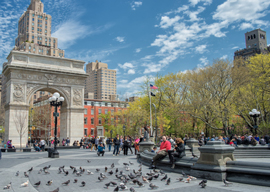
September 30, 2014

Washington Square Park
Source: Shutterstock
One evening back in the late 1980s, I returned to my then-apartment on Toronto’s Dundonald Street and heard the unmistakable refrain of “Ding-Dong! The Witch Is Dead” seeping out of the super’s place on the ground floor.
The elevator was broken (again) so I took the stairs to my fifth-floor flat. Three times, when I reached another landing, the song flared up again, from a unit on that floor. This “gay Doppler effect” experience, while decidedly low-key, was emblematic of my dozen or so years living in “Boystown.”
I presume even the raving-est straights know about the central role The Wizard of Oz plays in gay culture. Generations of hick-town homosexuals took their cues from Dorothy and her weird friends: as soon as they were old enough”and sometimes, before that”they ditched “Kansas” for a more welcoming “somewhere over the rainbow” in the big city.
In San Francisco, that somewhere was the Castro. In New York City, Greenwich Village. In Toronto”which once boasted the second largest such “hood on the continent”it was called Boystown, the Ghetto, or just the Village.
When I”d moved in, my intentions, while not exactly honorable, were really most sincerely non-sexual: quite simply, this apartment backed onto a beer store. (Yes, that’s what we call them.) In no time, cashiers were shouting “Two Snoopys” to the guys in the back whenever I shuffled in”a pair of “Red Baron” six-packs being so much easier for little old me to carry, even a few yards, than a single “12.”
I wasn”t exactly “the only straight in the Village” but sometimes it felt that way. Back then, the stretch of Church Street from Bloor as far as Gerrard was replete with rainbow flags, gay-owned/friendly establishments, and their sometimes disturbingly clone-y patrons. Alongside bars like Sailor and the Barn Stables, gift shops dealt in pink triangle lapel pins and Joan Crawford-themed birthday cards. Zelda’s, with its drag-queen-trailer-park-themed décor, was a beloved brunch destination.
On residential offshoots like Charles and Maitland, homes and gardens were lovingly, even competitively, tended. For Pride (which grew in length from a single summer day to a whole month during my tenancy) and “gay Christmas” (Halloween), festive decorations were hung early and often. “Any excuse for a party” was a phrase you heard almost as frequently as “It’s five o”clock somewhere.” Even the rare misanthropic gesture screamed “gay,” like the fellow who strung colored lights on his balcony to spell out “FUCK XMAS.”
Then, slowly, over the course of a decade, “pop and pop” neighborhood anchors like the Priape sex shop gave way to tacky “breeder” franchises, like fake British pubs and pizza joints. Perversely, the Second Cup demolished its famous “steps,” which had long served as the Ghetto’s 24/7 public square.
The Village took on the grim, grimy atmosphere of an off-season amusement park.
If you”re thinking “AIDS,” think again. I would have predicted the same cause once upon a time, as the 1990s saw more and more skeletal figures shuffling along the sidewalks, until they became names inscribed on the memorial in the same notorious park where the living still stubbornly cruised for sex and drugs.
But gay and straight observers alike agree: it wasn”t low T-cells but low interest rates that emptied out the Ghetto. Lifelong renters”like me”could suddenly afford homes of their own, but not in Boystown, where even a dilapidated house listed in the high six figures. Gays started colonizing (and, predictably, beautifying) new neighborhoods where buyers could get more house for their money: Cabbagetown, Leslieville, and even the once unthinkable Parkdale (now nicknamed Queer Street West).
Writing at Standpoint., Peter Whittle looks at a new book called There Goes the Gayborhood?“which “charts the apparent decline of so-called gay villages such as the Castro in San Francisco and Greenwich Village in New York, a decline, it’s suggested, which has come from the very success of the gay movement in being fully accepted into mainstream life.”
“Marriage, adoption, a revolution in public attitudes and sheer visibility,” Whittle writes, “have meant that there is simply no longer any need for the solidarity which came from clustering together in particular urban areas”areas which were often chosen for their cheapness, but which were then transformed by gay men with more dash than cash.”